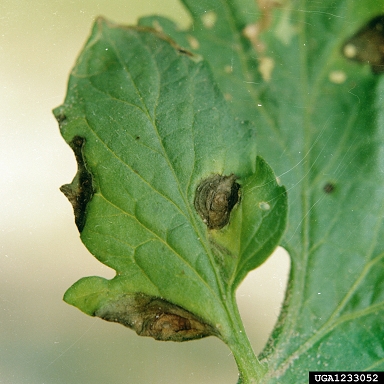
Early blight of tomato is a fungus disease usually caused by Alternaria solani or the more virulent A. tomatophila, and can also effect potatoes, peppers and other members of the nightshade family (Solanaceae). Foliar symptoms of A. solani appear first on the oldest leaves and start as dark brown or black lesions with a series of concentric rings surrounded by a yellowish halo. The lesions are about 1/2″ in diameter but the whole leaf may become yellow, wilt, and fall off. Infection may spread to the stem where the lesions are slightly sunken, oval to irregular, dry, brown and with dark brown concentric rings. The disease may also spread to immature or mature fruit where the lesions are black and leathery, have concentric ridges, and are usually near the stem. The spores of the fungus survive from year to year in soil and plant debris, and thrive in conditions of high humidity and rain that favor spore germination and spread. Photo Credit Clemson Wikimedia Commons
Control:
- Remove infected plants immediately and dispose of them to reduce the spread of the fungus.
- Wash tools, hands, and clothing that may carry the disease.
- Use a 3 year crop rotation scheme with crops from other plant families
- Remove and dispose of above ground crop residual
- Use resistant varieties
- Water in the morning using drip irrigation to reduce the time that moisture is on the leaves
- Mulch plants to reduce the effects of rain splashing spores onto plants
- Increase air circulation by increasing space between plants or trimming excess foliage
- Spray with a solution of 1 tablespoon baking soda, 2 1/tablespoons vegetable oil, and 1 teaspoon of liquid soap (not detergent) per gal of water. Repeat every 2 weeks, more often if rain washes the solution away.
- Spray with a prepared solution of Bacillus subtilis about every 2 weeks or when rain has washed it off the leaves.
- For very severe infestations spray with copper or sulfur, heeding cautionary warnings on the containers. These are more demanding solutions to the problem and the copper application will require special equipment.